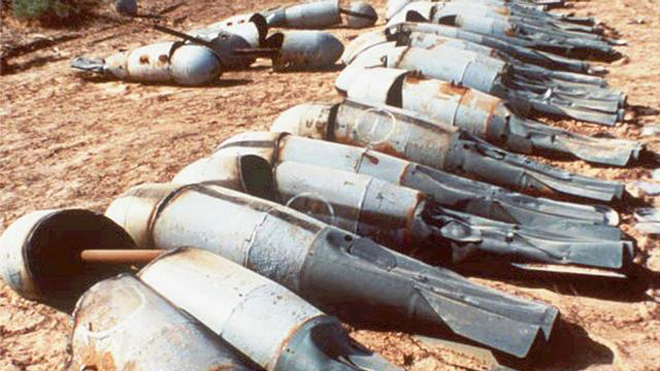Unexploded chemical weapons from U.S. tests at San Jose Island, Panama, containing dangerous agents of mass destruction such as mustard gas and hydrogen cyanide, could be headed to New Mexico for disposal, according to the Panamanian government.
A team of experts from the U.S. Department of Defense will evaluate “the fragility of chemical weapons in San Jose Island with the goal of moving and transporting them by sea toward to the New Mexico desert, where they will be buried,” according to a Nov. 21 statement posted online by Panama’s Foreign Minister Fernando Núñez Fábrega.
Following his Nov. 13 meeting with U.S. State Secretary John Kerry, the Panamanian official said the U.S. government had agreed to pay for the cleanup costs, and that removal of the chemical munitions will take place as soon as possible under an agreement with the U.S. government.
“In this way, Panama will be free of unexploded bombs in San Jose Island, and the (island) will be able to recover its touristic value,” Núñez Fábrega said.
In New Mexico, the desert regions are in the southern part of the state, which also encompass White Sands Missile Range, a vast military reservation.
The New Mexico governor’s office referred questions about the matter to the state Environment Department and the Energy, Minerals and Natural Resources Department.
“The U.S. Department of Defense would be the regulatory agency to oversee safety, security, and safeguarding the environment from the potential impacts of disposed weapons,” said Jim Winchester, spokesman for the state environment office. “The Department of Defense (or any other entity) has not contacted the state of New Mexico’s Environment Department in regards to this report.”
Neither the U.S. State Department nor the Department of Defense had responded to questions about the agreement with Panama, and that country’s statement that New Mexico was discussed as the destination for the chemical weapons.
A spokesman with the State Department said he would look into it, but had not responded by late Friday.
A State Department press announcement states that Kerry and Núñez Fábrega met in the department’s Treaty Room in Washington, D.C., on Nov. 15.
“We have also worked together closely on the issue of how to destroy some old Word War II chemical weapons munitions that are on San Jose Island, and we’re working on that issue as well as cooperating on counter-narcotics initiatives,” Kerry said in a video and statement that the State Department posted online, but without elaborating on the possible disposal site.
In October, Núñez Fábrega told the McClatchy News Service he had “a firm commitment from the United States” that the Pentagon will send a team to the island later in 2013 and that another team will dispose of the munitions next year.
McClatchy also reported that Panama sought help from the Organization for the Prohibition of Chemical Weapons at The Hague, Netherlands, in getting the U.S. government to remove the munitions from San Jose Island. The organization is the same one that oversees the destruction of chemical weapons in Syria.
The presence of U.S. chemical munitions in Panama is a lingering issue between the two countries. The United States tested weapons in the country from the 1930s to 1960s.
According to the International Fellowship of Reconciliation, an interfaith advocacy organization based in The Netherlands, mustard gas and distilled mustard, phosgene, cyanogen chloride, hydrogen cyanide, butane, and possibly also Lewisite were among the chemicals the U.S. military tested at San Jose Island.
“From available documents,” IFOR reported, “the number of munitions tested are known for 18 of the 130 tests conducted on San Jose Island. Some 4,397 chemical munitions were fired in these 18 tests, for an average of 244 munitions fired in each test.
“Most of the munitions fired — 3,816 — were 4.2-inch mortars charged with Cyanogen Chloride, mustard, or phosgene, but the chemical munitions also included bombs from 100 pounds to 1,000 pounds in weight and 105mm Howitzer shells,” reported IFOR, which has a U.S. counterpart, FOR-USA.
San Jose Project
John Lindsay-Poland, a member of FOR-USA, wrote about the San Jose Project chemical tests in his book “Emperors of the Jungle: The Hidden History of the U.S. in Panama,” (Duke University Press; 2003).
In an interview, the author in San Francisco said the U.S. government has a moral obligation to follow through on its commitment to rid the island of the dangerous munitions.
“(The) United States had an active chemical weapons program from at least 1930 until 1968,” Lindsay-Poland said in an article he wrote for Envio Digital. “From 1930 to 1946, this program focused on canal defense. From 1943 until 1968, the program aimed to test chemical munitions under tropical conditions. Dozens of tons of mustard gas and phosgene were stockpiled at a number of sites in Panama, particularly from the 1930s to the 1950s. Unused and dud chemical munitions were also abandoned in Panama.”
Lindsday-Poland said several of San Jose Island tests involved soldiers. “These included “patch tests,” which called for applying drops on a soldier’s forearms, often after protective ointment was put on one of them.
One of the U.S. tests was conducted to see if any difference existed in the sensitivity of Puerto Rican and Anglo-Saxon soldiers to mustard gas, Lindsay-Poland said.
“A summary of the (1944) test produced by Defense Secretary William Cohen in April 1998 implied that some men were hospitalized after they “sustained severe body burns or eye lesions,” Lindsay-Poland said.
“That was the mentality back then,” the author said.
